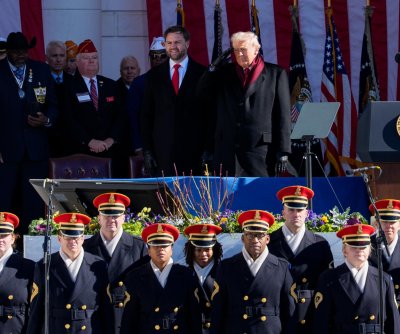Trump discusses Biden, changes name of holiday in Veterans Day speech

Vice President JD Vance and President Donald Trump attend a Veterans Day ceremony at Arlington National Cemetery Tuesday. Photo by Aaron Schwartz/EPA
Nov. 11 (UPI) — President Donald Trump mentioned political correctness, President Joe Biden and renaming Veterans Day at Arlington National Cemetery after laying a wreath for the holiday.
Trump said he plans to rename the holiday celebrated on Nov. 11 as “Victory Day for World War I.”
“You know, I was recently at an event and I saw France was celebrating Victory Day, but we didn’t,” he said. “And I saw France was celebrating another Victory Day for World War II, and other countries were celebrating. They were all celebrating.
“We’re the one that won the wars. … And we could do for plenty of other wars, but we’ll start with those two. Maybe someday somebody else will add a couple of more, ’cause we won a lot of good ones.”
Veterans Day was originally named Armistice Day to celebrate the end of World War I. But it eventually became Veterans Day to celebrate all who have served in the U.S. Armed Forces.
Since he took office, Trump has been on a renaming streak. He has renamed the Gulf of Mexico to the “Gulf of America,” the Persian Gulf to the “Arabian Gulf,” Mount Denali to “Mount McKinley” and the Department of Defense to the “Department of War.”
“Under the Trump administration, we are restoring the pride and the winning spirit of the United States military,” he said at Arlington. “That’s why we have officially renamed the Department of Defense back to the original name, Department of War.”
He also complained about political correctness.
“We don’t like being politically correct, so we’re not going to be politically correct anymore,” Trump said. “From now on when we fight a war, we only fight for one reason: to win.”
He thanked American troops for their service.
“And we want to also say thank you for carrying America’s fate on your strong, very broad, and proud shoulders,” he said. “Each of you has earned the respect and the gratitude of our entire nation.
“We love you. We salute you, and we will never forget what you have done to keep America safe, sovereign, and free.”
Trump also used the speech to attack the Biden administration and its management of the Veterans Administration.
“And the other thing is, we fired thousands of people who didn’t take care of our great veterans,” he said. “They were sadists. They were sick people. They were thieves. They were everything you want to name. And we got rid of over 9,000 of them.
“And then, when Biden came in, he hired them back, many of them. But we got rid of them. And I think we got rid of them permanently. We replaced them with people who love our veterans, not people who are sick people.”
The Department of Veterans Affairs laid off more than 2,400 people in February.


